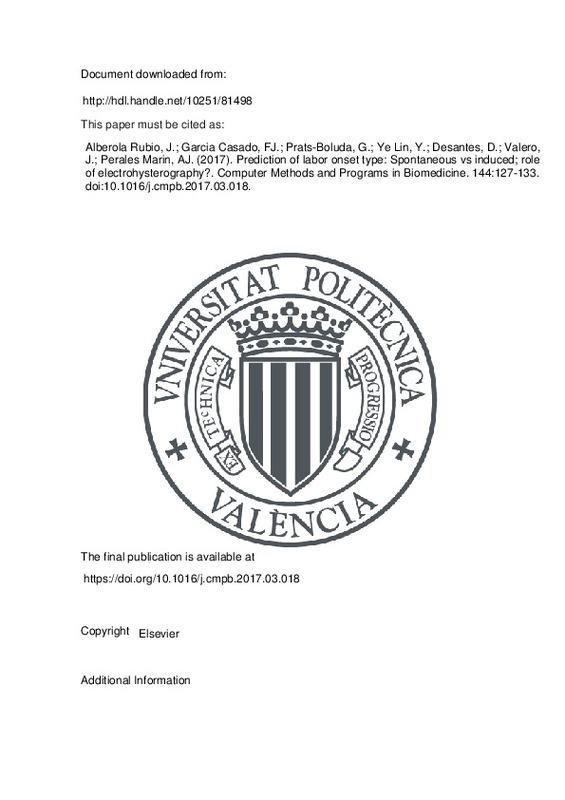JavaScript is disabled for your browser. Some features of this site may not work without it.
Buscar en RiuNet
Listar
Mi cuenta
Estadísticas
Ayuda RiuNet
Admin. UPV
Prediction of labor onset type: Spontaneous vs induced; role of electrohysterography?
Mostrar el registro sencillo del ítem
Ficheros en el ítem
| dc.contributor.author | Alberola Rubio, José
|
es_ES |
| dc.contributor.author | Garcia Casado, Francisco Javier
|
es_ES |
| dc.contributor.author | Prats-Boluda, Gema
|
es_ES |
| dc.contributor.author | Ye Lin, Yiyao
|
es_ES |
| dc.contributor.author | Desantes, D.
|
es_ES |
| dc.contributor.author | Valero, J.
|
es_ES |
| dc.contributor.author | Perales Marin, Alfredo Jose
|
es_ES |
| dc.date.accessioned | 2017-05-19T12:02:43Z | |
| dc.date.available | 2017-05-19T12:02:43Z | |
| dc.date.issued | 2017-03-28 | |
| dc.identifier.issn | 0169-2607 | |
| dc.identifier.uri | http://hdl.handle.net/10251/81498 | |
| dc.description.abstract | Background and objective Induction of labor (IOL) is a medical procedure used to initiate uterine contractions to achieve delivery. IOL entails medical risks and has a significant impact on both the mother's and newborn's well-being. The assistance provided by an automatic system to help distinguish patients that will achieve labor spontaneously from those that will need late-term IOL would help clinicians and mothers to take an informed decision about prolonging pregnancy. With this aim, we developed and evaluated predictive models using not only traditional obstetrical data but also electrophysiological parameters derived from the electrohysterogram (EHG). Methods EHG recordings were made on singleton term pregnancies. A set of 10 temporal and spectral parameters was calculated to characterize EHG bursts and a further set of 6 common obstetrical parameters was also considered in the predictive models design. Different models were implemented based on single layer Support Vector Machines (SVM) and with aggregation of majority voting of SVM (double layer), to distinguish between the two groups: term spontaneous labor (≤41 weeks of gestation) and IOL late-term labor. The areas under the curve (AUC) of the models were compared. Results The obstetrical and EHG parameters of the two groups did not show statistically significant differences. The best results of non-contextualized single input parameter SVM models were achieved by the Bishop Score (AUC = 0.65) and GA at recording time (AUC = 0.68) obstetrical parameters. The EHG parameter median frequency, when contextualized with the two obstetrical parameters improved these results, reaching AUC = 0.76. Multiple input SVM obtained AUC = 0.70 for all EHG parameters. Aggregation of majority voting of SVM models using contextualized EHG parameters achieved the best result AUC = 0.93. Conclusions Measuring the electrophysiological uterine condition by means of electrohysterographic recordings yielded a promising clinical decision support system for distinguishing patients that will spontaneously achieve active labor before the end of full term from those who will require late term IOL. The importance of considering these EHG measurements in the patient's individual context was also shown by combining EHG parameters with obstetrical parameters. Clinicians considering elective labor induction would benefit from this technique. | es_ES |
| dc.description.sponsorship | General Electric Healthcare | en_EN |
| dc.language | Inglés | es_ES |
| dc.publisher | Elsevier | es_ES |
| dc.relation.ispartof | Computer Methods and Programs in Biomedicine | es_ES |
| dc.rights | Reserva de todos los derechos | es_ES |
| dc.subject | Electrohysterogram | es_ES |
| dc.subject | SVM | es_ES |
| dc.subject | Majority voting | es_ES |
| dc.subject | Labor management | es_ES |
| dc.subject.classification | TECNOLOGIA ELECTRONICA | es_ES |
| dc.title | Prediction of labor onset type: Spontaneous vs induced; role of electrohysterography? | es_ES |
| dc.type | Artículo | es_ES |
| dc.identifier.doi | 10.1016/j.cmpb.2017.03.018 | |
| dc.relation.projectID | info:eu-repo/grantAgreement/GVA//GV%2F2014%2F029/ES/MONITORIZACION AMBULATORIA DEL ELECTROMIOGRAMA UTERINO PARA LA PREDICCION DEL PARTO PREMATURO%2FA TERMINO Y DEL TIPO DE FINALIZACION DEL MISMO/ | es_ES |
| dc.relation.projectID | info:eu-repo/grantAgreement/VLC%2FCAMPUS//ID34/ES/ | es_ES |
| dc.relation.projectID | info:eu-repo/grantAgreement/UPV//SP20120490/ | es_ES |
| dc.relation.projectID | info:eu-repo/grantAgreement/MINECO//DPI2015-68397-R/ES/ELECTROHISTEROGRAFIA, CONSTRUYENDO PUENTES PARA SU USO CLINICO EN OBSTETRICIA/ | es_ES |
| dc.rights.accessRights | Abierto | es_ES |
| dc.contributor.affiliation | Universitat Politècnica de València. Escuela Técnica Superior de Ingenieros Industriales - Escola Tècnica Superior d'Enginyers Industrials | es_ES |
| dc.contributor.affiliation | Universitat Politècnica de València. Instituto Interuniversitario de Investigación en Bioingeniería y Tecnología Orientada al Ser Humano - Institut Interuniversitari d'Investigació en Bioenginyeria i Tecnologia Orientada a l'Ésser Humà | es_ES |
| dc.contributor.affiliation | Universitat Politècnica de València. Escuela Técnica Superior de Ingeniería del Diseño - Escola Tècnica Superior d'Enginyeria del Disseny | es_ES |
| dc.contributor.affiliation | Universitat Politècnica de València. Servicio de Alumnado - Servei d'Alumnat | es_ES |
| dc.description.bibliographicCitation | Alberola Rubio, J.; Garcia Casado, FJ.; Prats-Boluda, G.; Ye Lin, Y.; Desantes, D.; Valero, J.; Perales Marin, AJ. (2017). Prediction of labor onset type: Spontaneous vs induced; role of electrohysterography?. Computer Methods and Programs in Biomedicine. 144:127-133. https://doi.org/10.1016/j.cmpb.2017.03.018 | es_ES |
| dc.description.accrualMethod | S | es_ES |
| dc.relation.publisherversion | https://doi.org/10.1016/j.cmpb.2017.03.018 | es_ES |
| dc.description.upvformatpinicio | 127 | es_ES |
| dc.description.upvformatpfin | 133 | es_ES |
| dc.type.version | info:eu-repo/semantics/publishedVersion | es_ES |
| dc.description.volume | 144 | es_ES |
| dc.relation.senia | 331820 | es_ES |
| dc.contributor.funder | Ministerio de Economía y Competitividad | es_ES |
| dc.contributor.funder | VLC/CAMPUS | es_ES |
| dc.contributor.funder | Universitat Politècnica de València | es_ES |
| dc.contributor.funder | Generalitat Valenciana | es_ES |
| dc.contributor.funder | GE Healthcare | es_ES |







![[Cerrado]](/themes/UPV/images/candado.png)

